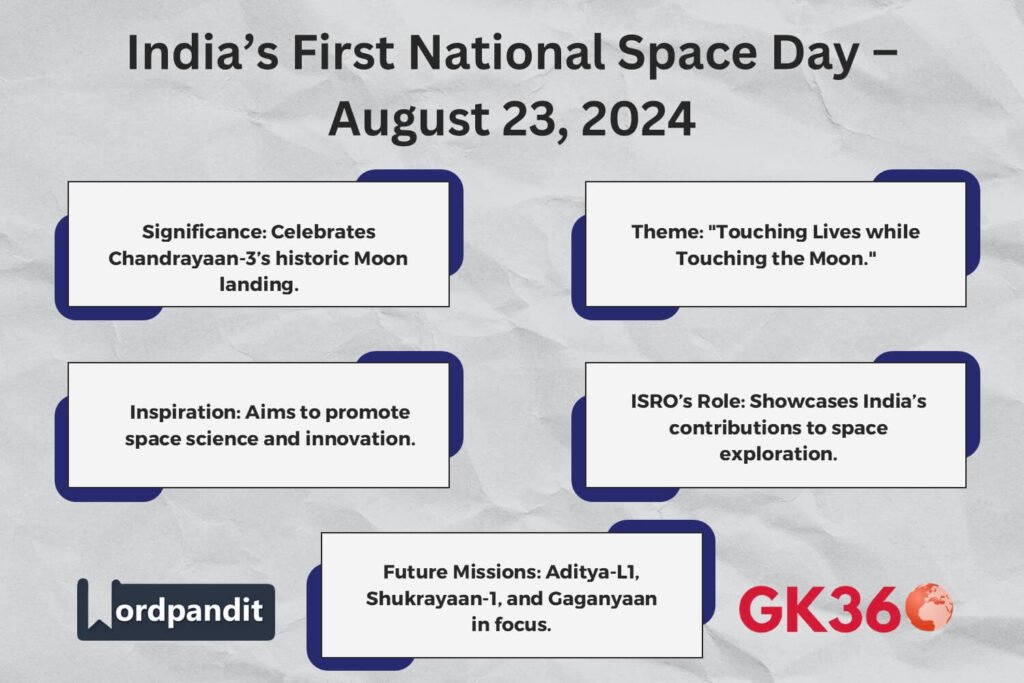National Space Day 2024: Date, Theme & India’s Space Achievements
Introduction
India is set to celebrate its first-ever National Space Day on August 23, 2024, marking a significant milestone in its space exploration journey. This special day commemorates the success of Chandrayaan-3, which made India the fourth nation to achieve a soft landing on the Moon. More than just a celebration, National Space Day is dedicated to inspiring future generations, promoting space science, and reaffirming India’s position as a global space leader.

Table of Contents
- What is National Space Day?
- Theme for National Space Day 2024: “Touching Lives while Touching the Moon”
- India’s Journey to the Moon: Chandrayaan Missions
- Chandrayaan-3: A Mission Breakdown
- Future of India’s Space Exploration
- How National Space Day is Celebrated
- Frequently Asked Questions (FAQs)
- Conclusion
What is National Space Day?
National Space Day, celebrated annually on August 23, was established to honor India’s space achievements and the one-year anniversary of Chandrayaan-3’s success. The day aims to ignite curiosity about space science, encourage young minds to pursue careers in space technology, and showcase India’s contributions to global space exploration.
Theme for National Space Day 2024: “Touching Lives while Touching the Moon”
The theme highlights how India’s space advancements impact everyday life, beyond just lunar exploration. It underscores:
- Technological Advancements: Satellite communication, remote sensing, and interplanetary missions.
- Societal Benefits: Applications in weather forecasting, disaster management, and telemedicine.
- Economic Growth: The role of space technology in job creation and innovation.
- International Collaboration: India’s partnerships with NASA, ESA, and other space agencies.
India’s Journey to the Moon: Chandrayaan Missions
Chandrayaan-1: The Pioneering Mission (2008)
- India’s first Moon mission.
- Discovered water molecules on the lunar surface.
- Paved the way for future lunar explorations.
Chandrayaan-2: Expanding Knowledge (2019)
- Attempted a soft landing near the Moon’s south pole.
- While the Vikram lander faced challenges, the orbiter continues to provide valuable data.
Chandrayaan-3: A Historic Soft Landing (2023)
- Achieved a successful soft landing, making India the fourth nation to do so.
- Deployed the Pragyan rover for lunar exploration.
- Enhanced India’s reputation in deep space exploration.
Chandrayaan-3: A Mission Breakdown
Mission Objectives:
- Soft Landing: Demonstrate India’s capability for controlled lunar descent.
- Rover Deployment: Conduct surface analysis using Pragyan rover.
- Scientific Exploration: Study the Moon’s terrain, seismic activity, and exosphere.
Mission Components:
- Vikram Lander: Ensured a successful lunar touchdown.
- Pragyan Rover: Collected and transmitted scientific data.
- Propulsion Module: Carried the lander-rover to lunar orbit.
Future of India’s Space Exploration
Aditya-L1: India’s First Solar Mission
- Aims to study the Sun’s outer layers, including solar radiation and coronal mass ejections.
Shukrayaan-1: Venus Mission
- Designed to explore Venus’ atmosphere and geological conditions.
Gaganyaan: India’s First Crewed Space Mission
- Plans to send Indian astronauts into space, advancing human spaceflight capabilities.
How National Space Day is Celebrated
- School & University Programs: Space workshops and competitions.
- ISRO Exhibitions: Showcasing India’s space achievements.
- Public Awareness Campaigns: Engaging citizens in space-related discussions.
Frequently Asked Questions (FAQs)
1. Why is National Space Day celebrated on August 23?
It marks the anniversary of Chandrayaan-3’s soft landing on the Moon, a major achievement for India.
2. How does ISRO contribute to everyday life?
ISRO’s satellites assist in weather forecasting, communication, disaster management, and navigation.
3. What is India’s biggest space achievement?
Besides Chandrayaan-3, India’s Mangalyaan (Mars Orbiter Mission) was a pioneering feat, making India the first nation to reach Mars on its first attempt.
4. What are India’s upcoming space missions?
Key upcoming missions include Aditya-L1 (solar mission), Shukrayaan-1 (Venus mission), and Gaganyaan (human spaceflight).
5. How can students participate in space research?
Students can join ISRO internship programs, participate in science fairs, and follow online courses on space technology.
Conclusion
National Space Day 2024 celebrates India’s past achievements while inspiring future space missions. As India continues its journey in space exploration, this day serves as a reminder of the nation’s scientific prowess and limitless potential. By engaging students, researchers, and the public, India paves the way for a new era of space innovation and discovery.
Key Takeaways
| Aspect | Details |
|---|---|
| Event | First-ever National Space Day on August 23, 2024. |
| Significance | Commemorates Chandrayaan-3’s successful Moon landing. |
| Theme | “Touching Lives while Touching the Moon.” |
| Chandrayaan-3 Achievements | India became the 4th country to achieve a soft landing on the Moon. |
| ISRO’s Upcoming Missions | Aditya-L1 (solar mission), Shukrayaan-1 (Venus), Gaganyaan (crewed mission). |
| India’s Space Legacy | Pioneering missions like Mangalyaan (Mars) and Chandrayaan series. |
| Impact on Society | Space tech benefits in communication, weather forecasting, and disaster management. |
Related Terms:
- National Space Day India 2024
- Chandrayaan-3 Moon landing
- ISRO space achievements
- India’s space missions 2024
- Aditya-L1 solar mission
- Shukrayaan-1 Venus mission
- Gaganyaan human spaceflight
- Space technology in India
- ISRO National Space Day theme
- Future of India’s space exploration






